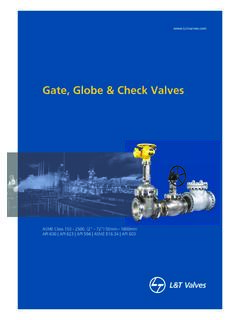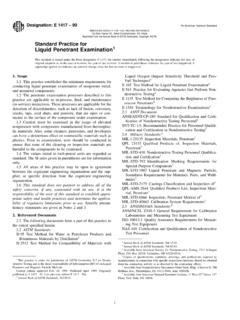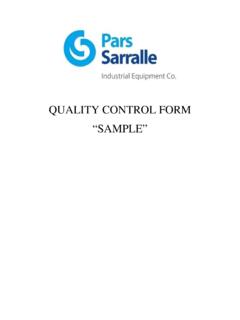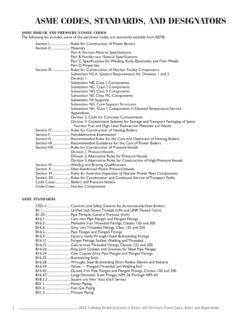Transcription of Charged Particle Accel - MIT
1 Resonant Cavities and Waveguides35612 Resonant Cavities and WaveguidesThis chapter initiates our study of resonant accelerators., The category includes rf(radio-frequency) linear accelerators, cyclotrons, microtrons, and synchrotrons. Resonantaccelerators have the following features in common:1. Applied electric fields are harmonic. The continuous wave (CW) approximation is valid;a frequency-domain analysis is the most convenient to use. In some accelerators, thefrequency of the accelerating field changes over the acceleration cycle; these changes arealways slow compared to the oscillation The longitudinal motion of accelerated particles is closely coupled to accelerating The frequency of electromagnetic oscillations is often in the microwave regime. Thisimplies that the wavelength of field variations is comparable to the scale length ofaccelerator structures.
2 The full set of the Maxwell equations must be theory relevant to accelerators is reviewed in this chapter. Chapter 13 describes thecoupling of longitudinal Particle dynamics to electromagnetic waves and introduces the concept ofphase stability. The theoretical tools of this chapter and Chapter 13 will facilitate the study ofspecific resonant accelerators in Chapters 14 and an introduction to frequency-domain analysis, Section reviews complex exponentialrepresentation of harmonic functions. The concept of complex impedance for the analysis ofpassive element circuits is emphasized. Section concentrates on a lumped element model forResonant Cavities and Waveguides357 (di/dt)% i% midt'V0cos t.( )the fundamental mode of a resonant cavity. The Maxwell equations are solved directly in to determine the characteristics of electromagnetic oscillations in resonant cavities.
3 Attentionis centered on the TM010mode because it is the most useful mode for Particle properties of resonators are discussed in Section Subjects include theQvalue of acavity and effects of competing modes. Methods of extracting energy from and coupling energyto resonant cavities are discussed in Section develops the frequency-domain analysis of transmission lines. There are threereasons to extend the analysis of transmission lines. First, an understanding of transmission lineshelps to illuminate properties of resonant cavities and waveguides. Second, transmission lines areoften used to transmit power to accelerator cavities. Finally, the transmission line equationsillustrate methods to match power sources to loads with reactive components, such as resonantcavities. In this application, a transmission line acts to transform the impedance of asingle-frequency input.
4 Section treats the cylindrical resonant cavity as a radial transmissionline with an open-circuit termination at the inner radius and a short-circuit termination at the reviews the theory of the cylindrical waveguide. Waveguides are extended hollowmetal structures of uniform cross section. Traveling waves are contained and transported in awaveguide; the frequency and field distribution is determined by the shape and dimensions of theguide. A lumped circuit element model is used to demonstrate approximate characteristics ofguided wave propagation, such as dispersion and cutoff. The waveguide equations are then final two sections treat the topic of slow-wave structures, waveguides with boundaries thatvary periodically in the longitudinal direction. They transport waves with phase velocity equal toor less than the speed of light. The waves are therefore useful for continuous acceleration ofsynchronized Charged particles .
5 A variety of models are used to illustrate the physics of theiris-loaded waveguide, a structure incorporated in many traveling wave accelerators. Theinterpretation of dispersion relationships is discussed in Section Plots of frequency versuswavenumber yield the phase velocity and group velocity of traveling waves. It is essential todetermine these quantities in order to design high-energy resonant accelerators. As an example,the dispersion relationship of the iris-loaded waveguide is COMPLEX EXPONENTIAL NOTATION AND IMPEDANCEC ircuits consisting of a harmonic voltage source driving resistors, capacitors, and inductors, aredescribed by an equation of the formThe solution of Eq. ( ) has homogeneous and particular parts. Transitory behavior mustResonant Cavities and Waveguides358i(t)'I0cos( t% ).( )cos t'[exp(j t)%exp(&j t)]/2,( )sin t'[exp(j t)&exp(&j t)]/2j.
6 ( )exp(j t)'cos t%jsin t.( )i(t)'Aexp(j t)%Bexp(&j t).( )include the homogenous part. Only the particular part need be included if we restrict our attentionto CW (continuous wave) excitation. The particular solution has the formI0and depend on the magnitude of the driving voltage, the elements of the circuit, and .Because Eq. ( ) describes a physical system, the solution must reflect a physical ,I0and are real numbers. They can be determined by direct substitution of Eq. ( )into Eq. ( ). In most cases, this procedure entails considerable manipulation of mathematics to determine the particular solution of Eq. ( ) and other circuit equationswith a single driving frequency can be simplified considerably through the use of the complexexponential notation for trigonometric functions. In using complex exponential notation, we mustremember the following facts:1.
7 All physical problems must have an answer that is a real number. Complex numbershave no physical Complex numbers are a convenient mathematical method for handling trigonometricfunctions. In the solution of a physical problem, complex numbers can always be groupedto form real The answers to physical problems are often written in terms of complex numbers. Thisconvention is used because the results can be written more compactly and because thereare well-defined rules for extracting the real-number following equations relate complex exponential functions to trigonometric functions:where. The symboljis used to avoid confusion with the current,i. The inversej'&1relationship isIn Eq. ( ), the expressionis substituted for the voltage, and theV0[exp(j t)%exp(&j t)]/2current is assumed to have the formResonant Cavities and Waveguides359A'(j V0/2) / (& 2%j % ),( )B'(&j V0/2) / (& 2&j % ).
8 ( )Aexp(j t)%A(exp(&j t)'I0[exp(j t)exp( )%exp(&j t)exp(& )]/2.( )A'I0exp(j )/2'I0(cos %jsin )/2( )A@A('I20(cos %jsin 'tan&1Im(A)/Re(A).( )The coefficientsAandBmay be complex numbers if there is a phase difference between thevoltage and the current. They are determined by substituting Eq. ( ) into Eq. ( ) andrecognizing that the terms involving exp(j t) and exp(-j t) must be separately equal if thesolution is to hold at all times. This procedure yieldsThe complex conjugate of a complex number is the number with -jsubstituted complex conjugate ofA. The relationship is denotedB=A*.Equations ( ) and ( ) represent a formal mathematical solution of the problem; we mustrewrite the solution in terms of real numbers to understand the physical behavior of the systemdescribed by Eq. ( ). Expressing Eq. ( )in complex notation and setting the result equal toEq.)))
9 ( ), we find thatTerms involving exp(j t) and exp(-j t) must be separately equal. This implies thatby Eq. ( ). The magnitude of the real solution is determined by multiplying Eq. ( ) by itscomplex conjugate:orInspection of Eq. ( ) shows that the phase shift is given byReturning to Eq. ( ), the solution isResonant Cavities and Waveguides360I0'V0 /( & 2)2% 2 2, 'tan&1( & 2)/ .i(t)'Aexp(j t).( )V/I'Z.( )ZR'R.( )V(t)'V0cos t,( )This is the familiar resonance solution for a driven, damped harmonic of the effort in solving the above problem was redundant. Because the coefficient of thesecond part of the solution must equal the complex conjugate of the first, we could have used atrial solution of the formWe arrive at the correct answer if we remember that Eq. ( ) represents only half of a validsolution. OnceAis determined, the real solution can be extracted by applying the rules of Eq.
10 ( ) and ( ). Similarly, in describing an electromagnetic wave traveling in the +zdirection,we will use the form. The form is a shortened notation for the functionE-E0exp[j( t&kz)]whereE0is a real number. TheE-E0exp[j( t&kz)]%E(0exp[&j( t&kz)]-E0cos( t&kz% )function for a wave traveling in the negative z direction is [j( t%kz)]Complex exponential notation is useful for solving lumped element circuits with CW excitation. Inthis circumstance, voltages and currents in the circuit vary harmonically at the driving frequencyand differ only in amplitude and phase. In complex exponential notation, the voltage and currentin a section of a circuit are related byThe quantityZ, the impedance, is a complex number that contains information on amplitude andphase. Impedance is a function of impedance of a resistorRis simplyA real impedance implies that the voltage and current are in phase as shown in Figure Thetime-averaged value ofVIthrough a resistor is nonzero; a resistor absorbs impedance of a capacitor can be calculated from Eq.)

















